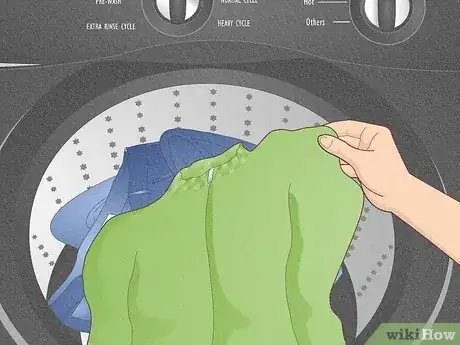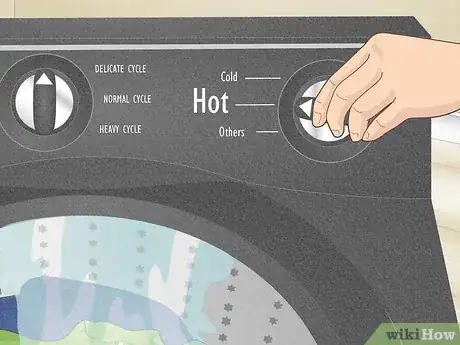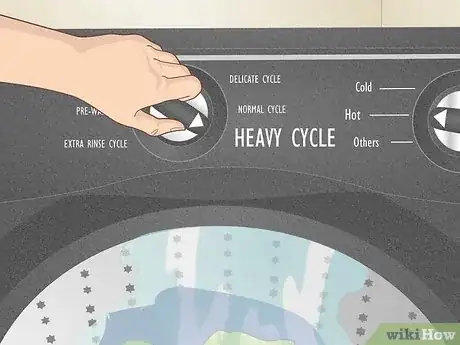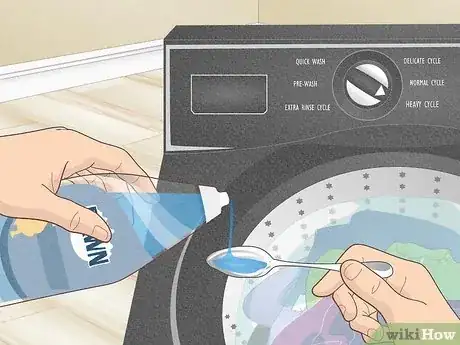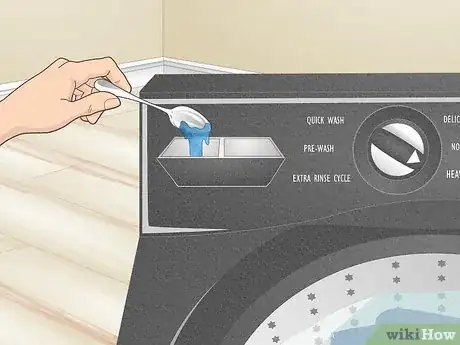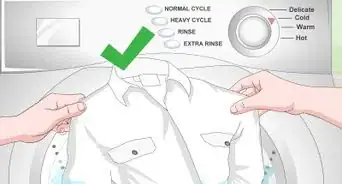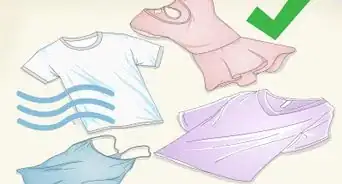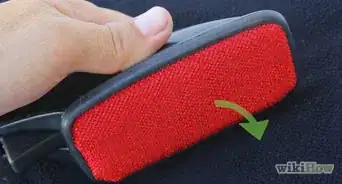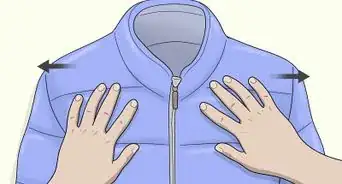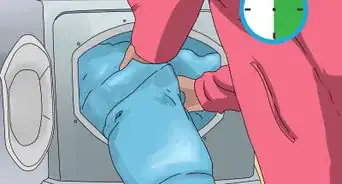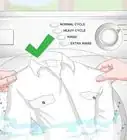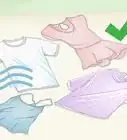This article was co-authored by Susan Stocker. Susan Stocker runs and owns Susan’s Green Cleaning, the #1 Green Cleaning Company in Seattle. She is well known in the region for outstanding customer service protocols — winning the 2017 Better Business Torch Award for Ethics & Integrity —and her energetic support of green cleaning practices.
wikiHow marks an article as reader-approved once it receives enough positive feedback. This article received 35 testimonials and 92% of readers who voted found it helpful, earning it our reader-approved status.
This article has been viewed 494,493 times.
Laundry detergent can be expensive, especially if you have a large family and have to do laundry frequently. To help cut down on costs, some people have found that using liquid dish soap can be a good replacement. Dish soap can cost much less than laundry detergent and can clean your clothes just as well. However, it's important to keep in mind that you will use a lot less dish liquid than laundry detergent. Adding too much dish soap will cause your washing machine to overflow with bubbles. Other than this, washing your clothes with dish liquid won't be any different than using laundry detergent.
Steps
Preparing Your Laundry
-
1Buy some liquid dish soap. Before you can wash your clothes using dish soap, you'll need to buy the dish soap itself. You won't need to worry about the brand or type of dish soap when shopping, as most any dish detergent will work just fine. Head out to the store and find a soap that has a scent that you enjoy to get started.[1]
- Make sure the dish detergent is bleach-free.
- You can buy any scent of dish detergent that you would like.
- You can also try adding your own scents with things like lavender oil.
-
2Add dirty clothes to the washer. You will need to gather up some dirty laundry to wash, just as you would normally when doing the laundry. Select whichever clothes you want to wash and put them into the washing machine. Keep some of the following standard tips in mind to help keep your clothes looking great:[2]
- Don't mix light and dark clothes.
- Heavy clothes, like jeans or towels, should be separated from lighter clothes.
- Do not wash brightly colored clothes with white laundry.
Advertisement -
3Choose the right temperature. While the dish detergent won't affect the temperature settings, you will still need to select them correctly. Higher temperatures may clean your clothes better than cooler temperatures. However, high temperatures can damage clothes easily. Here are some basic tips to help you keep your clothes safe during the wash:[3]
- Delicates and permanent press clothes should go on cold wash and cold rinse.
- Durable colors can go in on a warm wash and cold or warm rinse.
- Durable white clothes can be set to hot wash and cold rinse.
-
4Select the right cycle. Choosing a cycle for your laundry will help your clothes stay clean and prevent them from unnecessary wear and tear from the wash. Longer cycles are great for heavily soiled items, but they can also wear out delicate clothing. Shorter cycles are good for lightly soiled or delicate items. Here are some basic tips to help you pick the right wash cycle:[4]
- Quick washes are great for clothes that aren't very dirty or items that you want to wear again soon.
- Pre-wash can add an extra soak to help break up dirt.
- Permanent press settings will help maintain presses in any clothing items that have them.
- Heavy-duty will be a long cycle that will aggressively clean heavily soiled items. This setting is not recommended for delicate clothing.
- Delicate setting is used for fragile items that are easily damaged in the wash.
- Extra rinse will add another rinse cycle at the end of the wash, ensuring the clothes are clean.
Washing Your Clothes With Dish Detergent
-
1Measure the dish soap. Don't add the same amount of dish detergent as you would when using laundry detergent. If you add too much dish detergent, it will foam up and spill out of the machine. Always add the correct amount of dish detergent when using it for laundry to prevent a big mess.[5] [6]
- Add 1 teaspoon for small loads.
- Add 2 teaspoons for medium loads.
- Add 3 teaspoons for large loads.
-
2Add the dish soap and wash. Once you've measured out the correct amount of dish detergent, you can add it to the wash. Pour the dish detergent into the washing machine just like you would if you were using laundry detergent. After the dish detergent is added, let the washing machine do its thing.[7]
-
3Dry your clothes. After the washing machine has finished its washing cycle, it's time to dry the clothes. Drying your clothes can be done just as you would normally do when taking them out of a laundry detergent wash. Enjoy your fresh, clean clothes and the money you've saved by using dish detergent to do the laundry.[8]
Expert Q&A
-
QuestionDoes dishwashing liquid get stains out of clothes?
 Susan StockerSusan Stocker runs and owns Susan’s Green Cleaning, the #1 Green Cleaning Company in Seattle. She is well known in the region for outstanding customer service protocols — winning the 2017 Better Business Torch Award for Ethics & Integrity —and her energetic support of green cleaning practices.
Susan StockerSusan Stocker runs and owns Susan’s Green Cleaning, the #1 Green Cleaning Company in Seattle. She is well known in the region for outstanding customer service protocols — winning the 2017 Better Business Torch Award for Ethics & Integrity —and her energetic support of green cleaning practices.
Green Cleaning Expert Sure it does, specially for acrylic, latex, and water-based paint stains. If the paint is still wet, immediately put dishwashing liquid on it. Scrub and then rinse in cold water. If the paint’s already dried, it can still be done, but is a bit more time-consuming and you'd need to scrape the paint before washing.
Sure it does, specially for acrylic, latex, and water-based paint stains. If the paint is still wet, immediately put dishwashing liquid on it. Scrub and then rinse in cold water. If the paint’s already dried, it can still be done, but is a bit more time-consuming and you'd need to scrape the paint before washing. -
QuestionWhy does the dish detergent need to be bleach-free?
 Community AnswerIf the detergent contains bleach, it will ruin your clothes' colors by creating white spots.
Community AnswerIf the detergent contains bleach, it will ruin your clothes' colors by creating white spots. -
QuestionThe images seem to portray a dessert spoon, which is about twice the capacity of a teaspoon. Do I need three teaspoons or three dessert spoons of soap for a large laundry load?
 Community AnswerIf you want to be precise, use a measuring teaspoon - like the kind you use for cooking. And remember, 3 teaspoons equal one tablespoon. So if you are doing a large load, you can use a measuring tablespoon.
Community AnswerIf you want to be precise, use a measuring teaspoon - like the kind you use for cooking. And remember, 3 teaspoons equal one tablespoon. So if you are doing a large load, you can use a measuring tablespoon.
Warnings
- Don't add too much detergent as this can result in an overflow.⧼thumbs_response⧽
Things You'll Need
- Dish soap
- Dirty laundry
References
- ↑ http://premeditatedleftovers.com/naturally-frugal-living/use-dish-soap-wash-laundry-naturally-frugal-tip/
- ↑ http://premeditatedleftovers.com/naturally-frugal-living/use-dish-soap-wash-laundry-naturally-frugal-tip/
- ↑ http://www.apartmenttherapy.com/what-the-heck-is-permanent-press-anyway-washer-dryer-settings-explained-185501
- ↑ http://www.apartmenttherapy.com/what-the-heck-is-permanent-press-anyway-washer-dryer-settings-explained-185501
- ↑ http://premeditatedleftovers.com/naturally-frugal-living/use-dish-soap-wash-laundry-naturally-frugal-tip/
- ↑ http://www.home-ec101.com/bubble-bubble-toil-and-trouble/
- ↑ http://www.home-ec101.com/bubble-bubble-toil-and-trouble/
- ↑ http://premeditatedleftovers.com/naturally-frugal-living/use-dish-soap-wash-laundry-naturally-frugal-tip/
About This Article
To wash your clothes with dish liquid, start by putting the dirty clothes in the washing machine and choosing the wash temperature. Then, measure out the dish soap, using 1 tsp for a small load or 3 tsp for a large load of clothes. Next, add the soap to the washing machine the same way you would pour in laundry detergent. Run the washing machine, then dry your clothes as usual. For tips on choosing the right wash cycle for your laundry, read on!

